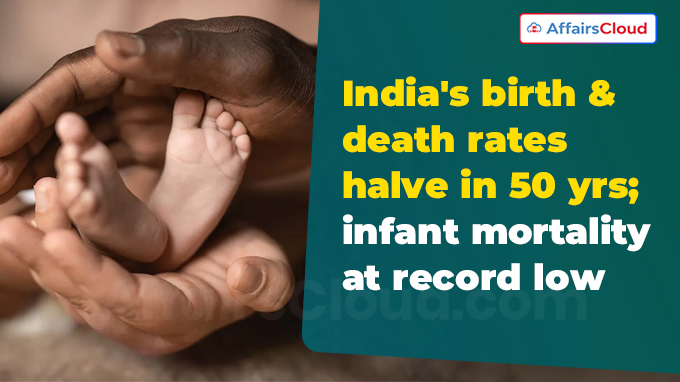In September 2025, the Office of the Registrar General & Census Commissioner of India (RGI&CCI) which works under the Ministry of Home Affairs (MHA), has released the Sample Registration System (SRS) Bulletin 2023. The report highlighted that for the 1st time, India’s birth and death rates have declined to nearly 50% i.e. to 18.4 and 6.4 in 2023, compared to 36.9 and 14.9 (in 1971), respectively.
- While, Infant Mortality Rate (IMR) has dropped to record low, from 129 deaths per 1,000 live births (in 1971) to 25 (in 2023). This IMR recorded in 2023 also marks a decline of 37.5% compared to 2013 level.
Exam Hints:
- What? Release of SRS Bulletin 2023
- Released by: Office of the (RGI&CCI), MHA
- Indicators: birth rate (18.4), death rate (6.4), IMR (25)
- Highest Birth Rates: Bihar (25.8), UP (23.6) and Rajasthan (22.9)
- India’s TFR: 1.9 (2023)
- Life Expectancy: Males – 68.5 yrs; Females – 72.5 yrs
– Elderly Population (60+ yrs): 9.7% of total
– Gross Reproductive Rate (GRR): 0.9
Key Findings of SRS 2023 Report:
Birth Rate:
Top 5 States/UTs: The birth rate of Bihar stood at 25.8 in 2023, the highest among all States/Union Territories (UTs); followed by Uttar Pradesh (UP) (23.6), Rajasthan (22.9), Madhya Pradesh (MP) (22.5) and Chhattisgarh (22.3).
Bottom 5 States/UTs: Among all States/UTs, Andaman & Nicobar Islands registered the lowest birth rate in 2023 i.e. at 10.1. It is followed by Kerala (12.3); Tamil Nadu (TN) (12.0), Punjab (13.8) and Maharashtra/West Bengal (WB) (14.0) each.
Rural and Urban Difference: The report showed that rural India registered a higher birth rate of 20.3, in contrast to it, urban areas witnessed a sharper decline i.e. to 14.9 for the same time period.
Death Rate:
Top 5 States/UTs: Chhattisgarh had the highest death rate at 8.3 compared to all States/Union Territories (UTs); followed by Odisha (7.7), Kerala (7.2), Punjab (7.3) Andhra Pradesh (AP) (6.9) and Karnataka (6.8).
Bottom 5 States/UTs: Among all States/UTs, Chandigarh registered a lowest birth rate in 2023 i.e. at 4.0. It is followed by Delhi/Manipur (4.5) each, and Jammu & Kashmir (J&K) (5.6).
Gender-basis: At national level, men recorded a higher death rate (7.2) compared to women (5.7) both in rural and urban areas of the country.
Rural and Urban Difference: The report showed that rural and urban regions of the country registered death rates at 6.8 and 5.7, respectively.
IMR:
Highest IMR: Chhattisgarh, UP and MP registered the highest IMR i.e. at 37 each; followed by Odisha and Assam (30); and Jharkhand and Rajasthan (29).
Lowest IMR: Manipur recorded a lowest registered the highest IMR, at 3, far below the national average (25). It is followed by UT Ladakh (4), Kerala (5), Goa/Sikkim (6) each and UTs Chandigarh and Puducherry (7) each.
Rural and Urban Areas: IMR in rural regions, decreased from 36 (in 2018) to 28 (in 2023), while urban regions recorded a decline of 5 points, from 23 (in 2018) to 18 (in 2023).
Average Life Expectancy:
Top 5 States/UTs: Kerala’s life expectancy was above 78.4 years (in 2023), the highest among all states and UTs in the country; followed by Delhi (around 74.2 years), Himachal Pradesh (HP) (around 74.4 years) and J&K (around 73.4 years).
Bottom 5 States/UTs: The average life spans of states like MP, UP, and Assam, are shorter than the national average.
Males & Female: As per the SRS-based Abridged Life Tables 2019-2023, India’s average life expectancy for males and females in 2023, was at around 68.5 years and 72.5 years, respectively.
Total Infertility Rate (TFR):
At National Level: India’s TFR has decreased from 2.0 (in 2022) to 1.9 (in 2023), far below the 5.2 recorded in 1971.
- The report highlighted that a total of 18 states and UTs now have TFR below the replacement level.
States with highest TFR: Bihar recorded the highest TFR among all Indian states i.e. at 2.8; followed by UP (2.6), MP (2.5), Rajasthan (2.3), and Chhattisgarh (2.2).
States with lowest TFR: UT Delhi recorded the lowest TFR among all Indian states i.e. at 1.2; followed by WB and TN (1.3) each, Maharashtra (1.4), Kerala and AP (1.5) each.
Other Key Indicators:
Proportion of Elderly People: The datasets of SRS 2023 revealed that the proportion of the elderly people in India (people above the age of 60), has increased by 0.7% percentage points annually, to 9.7% of the population.
- Top 3 states: Kerala (15%); Assam (7.6%) and Delhi (7.7%).
GRR: The report showed that GRR for 2023 is projected at 0.9. Also, the GRR for major states/UTs range from 0.6 (Delhi, WB, and TN) to 1.3 (Bihar).
CBR: A per SR 2023 data, India’s Crude Birth Rate (CBR) has decreased from 19.1 (in 2022) to 18.4 (in 2023).
Important Terms:
Birth Rate: The number of live births per 1,000 people in a population during a specific year.
Infant Mortality Rate (IMR): The number of deaths of children under one year of age per 1,000 live births.
Gross Reproductive Rate (GRR): It is an indicator for fertility that accounts for future mothers and measures the average number of female children a woman is expected to give birth during her entire reproductive span.
Crude Birth Rate(CBR): It refers to the number of children born per 1,000 people in the population in a year.
About Registrar General & Census Commissioner of India (RGI&CCI):
Registrar General of India (RGI)- Mrityunjay Kumar Narayan
Headquarters– New Delhi, Delhi
Established -1949




